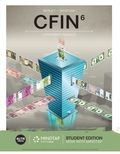
Bond L has a face value of $1,000 with annual interest rate of $100, matures in 15 years with rate of interest of a) 5 percent and b) 7 percent. Bond S also has a face value of $1,000 and an annual interest rate of $100, matures in 15 years with rate of interest of a) 5 percent and b) 7 percent.
Bonds are issued to raise funds for the company. The important characteristic of a bond is that it has a maturity value which is the value the bondholders will get at the end of the maturity period. Also, some bonds carry coupon rate which means the bondholders will get a regular interest cash flow on that bond.
The yield to maturity (YTM) of the bond is the required
Where,
INT = coupon payments made
N = number of periods
M = Maturity or Face value
rd = rate of return
Vd = Value of the bond
Want to see the full answer?
Check out a sample textbook solution
- A company issued bonds with a $100,000 face value, a 5-year term, a stated rate of 6%, and a market rate of 7%. Interest is paid annually. What is the amount of interest the bondholders will receive at the end of the year?arrow_forwardKrystian Inc. issued 10-year bonds with a face value of $100,000 and a stated rate of 4% when the market rate was 6%. Interest was paid semi-annually. Calculate and explain the timing of the cash flows the purchaser of the bonds (the investor) will receive throughout the bond term. Would an investor be willing to pay more or less than face value for this bond?arrow_forwardOn January 1, 2018, Wawatosa Inc. issued 5-year bonds with a face value of $200,000 and a stated interest rate of 12% payable semi-annually on July 1 and January 1. The bonds were sold to yield 10%. Assuming the bonds were sold at 107.732, what is the selling price of the bonds? Were they issued at a discount or a premium?arrow_forward
- On July 1, a company sells 8-year $250,000 bonds with a stated interest rate of 6%. If interest payments are paid annually, each interest payment will be ________. A. $120,000 B. $60,000 C. $7,500 D. $15,000arrow_forwardOn July 1, Somerset Inc. issued $200,000 of 10%, 10-year bonds when the market rate was 12%. The bonds paid interest semi-annually. Assuming the bonds sold at 58.55, what was the selling price of the bonds? Explain why the cash received from selling this bond is different from the $200,000 face value of the bond.arrow_forwardCharleston Inc. issued $200,000 bonds with a stated rate of 10%. The bonds had a 10-year maturity date. Interest is to be paid semi-annually and the market rate of interest is 8%. If the bonds sold at 113.55, what amount was received upon issuance?arrow_forward
- Evie Inc. issued 50 bonds with a $1,000 face value, a five-year life, and a stated annual coupon of 6% for $980 each. What is the total amount of interest expense over the life of the bonds?arrow_forwardThe Garraty Company has two bond issues outstanding. Both bonds pay $100 annual interest plus $1,000 at maturity. Bond L has a maturity of 15 years, and Bond S has a maturity of 1 year. b. Why does the longer-term (15-year) bond fluctuate more when interest rates change than does the shorter-term bond (1 year)?arrow_forwardThe FAMA Company has two bond issues outstanding. Both bonds pay $100 annual interest plus $1000 face value at maturity. Bond L has a maturity of 15 years, and Bond S has a maturity of 1-year. What will be the value of each of these bonds when the going rate of interest (yield to maturity) is: 8% 12% Why does the longer-term (15-year) bond fluctuate more when interest rates change than does the shorter-term bond (1-year)?arrow_forward
- The saleemi corporation’s $1,000 bonds pay 6 percent interest annually and have 11 years until maturity. You can purchase the bond for $875. A. What is the yield to maturity on this bond? B. Should you purchase the bond if the yield to maturity on a comparable-risk bond is 6 percent? A. The yield to maturity on the saleemi bonds is Round to two decimal placesarrow_forwardThe saleemi corporation’s is $1,000 bonds pay 9 percent interest rate annually and have 9 years until maturity. You can purchase the bond for $935. A. What is the yield to maturity on this bond? B. Should you purchase the bond if the yield to maturity on a comparable-risk bond is 9 percent ? A. The yield to maturity on the saleemi bonds is Round to two decimal placesarrow_forwardThe company issues 10.0%, 10-year bonds with a total face amount of $1,000,000. The market interest rate for bonds of similar risk and maturity is 9.8%. Interest is paid semi-annually. DO NOT ROUND YOUR ANSWERS UNTIL YOU FULLY COMPLETE THE PROBLEM SET. 1. $ 2. $ 3. $ How much will be paid in interest each interest payment? (rounded to nearest dollar). What is the present value of the interest payments? (rounded to nearest dollar). What is the issue price of the bond?arrow_forward
 Principles of Accounting Volume 1AccountingISBN:9781947172685Author:OpenStaxPublisher:OpenStax College
Principles of Accounting Volume 1AccountingISBN:9781947172685Author:OpenStaxPublisher:OpenStax College College Accounting, Chapters 1-27AccountingISBN:9781337794756Author:HEINTZ, James A.Publisher:Cengage Learning,
College Accounting, Chapters 1-27AccountingISBN:9781337794756Author:HEINTZ, James A.Publisher:Cengage Learning,


